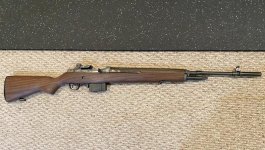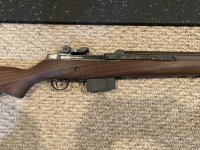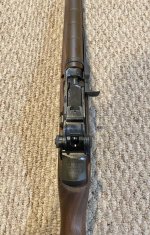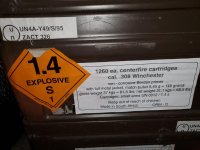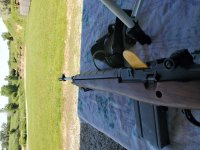Dave and others have mostly covered it.
I shot NM M14s in the early 1980s and my own Springfield M1A Supermatch for a decade or so after that and I still have a rack grade M1A jus because.
The M1A's gas system is far more tolerant of slower burning powders than the M1 Garand and won't bend the op rod as readily, but stay with powders in the IMR-4895, BL-C(2), Reloader 15, and IMR 4064 range.
BL-C(2) works very well with 150 gr FMJs as a more or less M80 Ball load. It's easy and accurate metering and can be used to make a lot of ammo in not a lot of time on a progressive press like a Dillon 550B.
IMR-4064 has been a decades long go to load for the 168 gr SMK as a 600 yard match load and it's a great choice with a 175 gr SMK as a 1000 yard match load.
Military M80 Ball and foreign equivalent ammunition is fine for use as well as M852 Match ammo (168 gr SMk), M118 Special Ball (Lake City produced 173 gr BTFMJ bullet), or M118LR (175 gr SMK) ammo all works fine and was designed for use in or to be compatible with the M14/M1A.
Accuracy wise, expect about 3-4 MOA with M80 ball ammo. With match ammo or hand loaded equivalent you should be able to get 2 MOA with a rack grade M1A and maybe 1.5 MOA with a load it likes. 1 MOA and sub MOA accuracy really requires a match barrel, the stock to be bedded and the gas system and barrel band be unitized to reduce the horizontal and vertical dispersion.
——
Springfield Armory makes a scope mount that replaces the stripped clip guide and in that case it's not a bad idea to get the plastic receiver insert to keep the bolt open while cleaning.
By necessity it cleans from the muzzle and you need to take care to not let the cleaning rod wear on the rifling at the muzzle. A bore guide is a very good idea. The flash hider limits the damage, but he rod can still wear on the muzzle.
I mill bore guides on my lathe that fit inside the flash hider to center the rod in bore and that approach works fine with a .22 caliber rod.
Similarly one of the cone shaped bore guides that slides on the cleaning rod works well as it centers the rod in the flash hider.
I am normally an advocate of using a .30 caliber cleaning rod in a .308 bore as it won't flex as much and potentially contact the rifling and rub on it with excessive pressure.
However, the M1A, M1 Garand and BM-59 are exceptions as they clean from the muzzle and the bore guide cannot be in contact with the muzzle due to the flash hider. A flash hider that is a few thou off center will leave a .30 caliber rod rubbing one side of the rifling at the muzzle, while the same mis alignment with a .22 caliber rod is a non issue, and a cleaning rod made for a .270 or .284" bore is ideal.
—-
"If it's shiny, put grease on it" is the general rule with the M1, M1A and BM-59. The roller and recess in the slide should be liberally greased as should be the top of the locking lug on the other side of the bolt. The top of the rear of the bolt should be greased, as well as the round arm on the hammer. The square tab on the back of the slide that fits in the slot in the receiver should be greased. There is often a contact point on the bottom of the barrel that wears a shiny spot. Grease it as well.
What kind of grease? It really doesn't matter much. I have a couple 1 pound cans of military rifle grease left over from a half dozen cans I bought in the 1980s. Some folks swear mil spec is always best but I strongly suspect those people never served in the military, or if they did they don't understand what mil spec means. In the case of mil spec rifle grease the only spec considered was how well it resisted being washed off. Any automotive grease will meet or exceed that WWII era specification, will probably have better heat resistance and will probably have better lubrication properties. So use whatever you want.
—-
As far as I know and can tell, Springfield Armory still uses a traditional pure tung oil dipped stock finish. It doesn't do a great job of sealing the wood so it will benefit from a hand rubbed coat of pure tung oil every time you clean it.
All three of these rifles started out with that same flat looking dipped tung oil finish. The Garand stock is a GI stock, the M1A is a Springfield Armory produced rifle, and the BM-59 got a new production stock when it was rebuilt by James River Armory.
The Garand at the bottom acquired a satin finish with the grain filled through the process of GIs wiping it down whenever they had the chance as part of the cleaning process with a rag and some tung oil or linseed oil. Tung oil was and remains preferable as it creates a harder finish and doesn't have the yellow tint of linseed oil.
Both the others have gotten a periodic rub down with pure tung oil and a piece of cheese cloth. The resulting finish after a half dozen or so rub downs is a pleasant semi gloss with a much better sealed grain. Eventually the grain will be fully filled as not all of the oil is wiped back off the low spots in the grain and the thin layer that is left builds up over time. Wiping with cheese cloth helps remove any dust or dirt down in the grain.
This picture gives a better idea of the semi gloss that results:
Tru oil will work and creates a very hard surface finish, but it's also way too shiny. You'll have to put on a half dozen coats and then knock down the shine with 0000 steel wool, being careful not to cut all the way through the finish as you do so. Periodic application of pure tung oil takes longer, but it produces a more correct finish in the long term.
—-
If your M1A is glass bedded remove it from the stock only when absolutely necessary. The way the rifle is designed the lugs in the stock drag on the bedding a bit as the receiver tilts in and out of the stock, even if the are rounded a bit as part of the preparation for bedding the receiver in the stock. If properly done the bedding should be steel or aluminum filled for durability, but it will wear a bit with each removal.
When I shot a lot of service rifle competition, I re-barrelled the rifle every 8,000-10,000 rounds, and also refreshed the bedding at that time, grinding out 1/4" of bedding in the high wear areas and re-bedding those area while scuffing and the skim bedding the rest.
If properly glass bedded, it should have had only a single coat of release agent and should fit very tight in the stock. It will require holding the rifle by the sight ears with the flash hider on a soft surface and then whacking the top of the butt stock several times with your hand to get it to come out of the stock.
I rebarrelled and rebedded my M1A Supermatch after I had switched to an AR-15 and sold it on consignment through a shop. A week or so after it sold the shop called me as the new owner was concerned the action would not come out of the stock.
I had removed it after bedding for clean up purposes so I knew it was fine and told the shop owner that. I also told him to tell the moron who bought it to leave it alone. Shooting about 5000 rounds per season, I only pulled it out of the stock once in the middle of the season and once at the end of the season for a thorough clean and lube. I told him to tell the owner not to mess with it until he had 2500 rounds through it, as every time he removes the receiver from the stock it will degrade the accuracy - and if that wasn't ok, I'd buy it back from him.
——
If the stock is not glass bedded, pull the receiver out of the stock and clean the rifle as much as you like (and apply pure tung oil to the inside of the stock with cheesecloth as well to clean the gunk and seal the wood).
A tilt test can be used to determine if the gas piston needs cleaned, but excessive cleaning isn't going to hurt it. Just get a gas piston wrench for it and don't over torque it. Just past finger tight is plenty.
A tilt test with the recoil spring removed and the action in the stock can also be done to ensure the slide isn't rubbing on the stock somewhere. The slide and bolt should move back and forth easily as you move it muzzle up and muzzle down.

